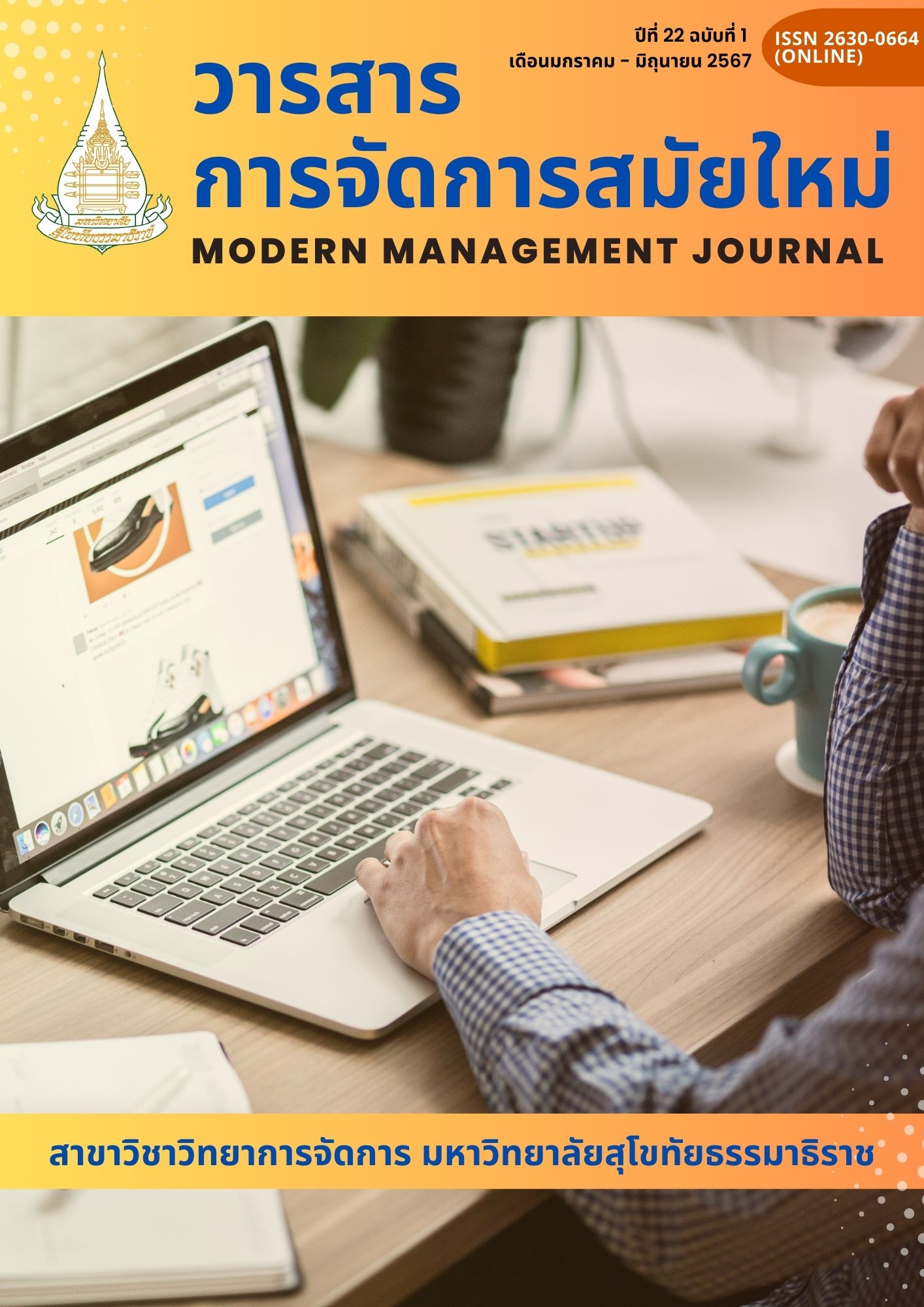ผลกระทบของประสบการณ์ในสนามบินที่ส่งผลต่อความสุข ความพึงพอใจ และภาพลักษณ์ของท่าอากาศยานแม่ฟ้าหลวง เชียงราย
คำสำคัญ:
ภาพลักษณ์, ประสบการณ์, ความพึงพอใจ, ท่าอากาศยานแม่ฟ้าหลวง เชียงรายบทคัดย่อ
การศึกษาครั้งนี้มีวัตถุประสงค์ 1) เพื่อศึกษาการรับรู้ประสบการณ์ ความสุข ความพึงพอใจของผู้ใช้บริการ และการรับรู้ภาพลักษณ์ของท่าอากาศยานแม่ฟ้าหลวง เชียงราย 2) เพื่อศึกษาเปรียบเทียบการรับรู้ประสบการณ์ ความสุข ความพึงพอใจ และภาพลักษณ์ จำแนกตามปัจจัยส่วนบุคคลของผู้ใช้บริการ และ 3) เพื่อศึกษาผลกระทบทางตรงและทางอ้อมของการรับรู้ประสบการณ์ ความสุข ความพึงพอใจของผู้ใช้บริการที่มีต่อการรับรู้ภาพลักษณ์ของท่าอากาศยานแม่ฟ้าหลวง เชียงราย โดยกลุ่มตัวอย่างคือ ผู้ใช้บริการชาวไทยที่ใช้บริการของท่าอากาศยานแม่ฟ้าหลวง เชียงราย จำนวน 400 คน ซึ่งใช้วิธีการเลือกตัวอย่างแบบเจาะจง โดยมีเกณฑ์การคัดเลือกคือ ผู้ที่เคยใช้บริการในช่วง 2 ปีที่ผ่านมา และใช้แบบสอบถามเป็นเครื่องมือในการเก็บข้อมูล วิเคราะห์ข้อมูลโดยใช้สถิติเชิงพรรณนา การทดสอบค่าที การวิเคราะห์ความแปรปรวนทางเดียว การวิเคราะห์องค์ประกอบเชิงยืนยัน และการวิเคราะห์เส้นทาง ผลการศึกษาพบว่า 1) การรับรู้ประสบการณ์ของผู้ใช้บริการและภาพลักษณ์ของท่าอากาศยานแม่ฟ้าหลวง เชียงราย อยู่ในระดับมาก ส่วนความสุขและความพึงพอใจอยู่ในระดับปานกลาง 2) การรับรู้ประสบการณ์ ความสุข ความพึงพอใจ และภาพลักษณ์ พบว่ามีความแตกต่างตามปัจจัยส่วนบุคคลของผู้ใช้บริการ อย่างมีนัยสำคัญทางสถิติที่ระดับ 0.05 และ
3) การรับรู้ประสบการณ์ด้านประสาทสัมผัสมีผลกระทบทางตรงต่อความสุขและมีผลกระทบทางอ้อมต่อทั้งความพึงพอใจและการรับรู้ภาพลักษณ์ของท่าอากาศยานแม่ฟ้าหลวง เชียงราย อย่างมีนัยสำคัญทางสถิติที่ระดับ 0.05
เอกสารอ้างอิง
Airport of Thailand PLC. (2023). About Us - Mae Fah Luang Airport. Retrieved from https://chiangrai.airportthai.co.th/about-us. [In Thai]
Anderson, E. W., Fornell, C., & Lehmann, D. R. (1994). Customer Satisfaction, Market Share, and Profitability: Findings from Sweden. Journal of Marketing, 58(3), 53. https://doi.org/10.2307/1252310
Ariffin, A. A. M., & Yahaya, M. F. (2013). The relationship between airport image, national identity and passengers delight: A case study of the Malaysian low cost carrier terminal (LCCT). Journal of Air Transport Management, 31, 33-36.
Bigne´, J.E., Andreua, L., & Gnoth, J. (2005). The theme park experience: An analysis of pleasure, arousal and satisfaction. Tourism Management, 26, 833–844.
Bunyapattanapong, W. (2022). Airport management factors affecting the passenger experience at Phuket International Airport. Journal of Humanities and Social Sciences Thonburi University, 17(1), 147-158. [In Thai]
Chao, A. W., Mess, K. H., Tigner, M., & Zimmermann, F. (2012). Handbook of Accelerator Physics and Engineering. WORLD SCIENTIFIC eBooks. https://doi.org/10.1142/8543
Chanagumchokcharoen, F. (2020). Influence of experiential marketing towards satisfaction through intention to recommend and revisit of Thai tourists in Museum Siam. Doctoral dissertation. Bangkok: Silpakorn University. [In Thai]
Chanawutthikulkiti, C. (2018). Factors associated with service quality perceived by the users of Udon Thani International Airport. Chophayom Journal, 29(2), 15-25. [In Thai]
Chotipanich, W. (2017). Impact of Service Quality, Perceived Value and Brand Image on Re-service Intention in Context of Full-service Airlines. Bangkok: Bangkok University [In Thai]
Clemes, M.D., Gan, C., Kao, T-H., & Choong, M. (2008). An empirical analysis of customer in international air travel. Innovative Marketing, 4(2), 49-62.
Giovanis, A., Zondiros, D., & Tomaras, P. (2014). The antecedents of customer loyalty for broadband services: The role of service quality, emotional satisfaction and corporate image. Social and Behavioral Sciences, 148, 236-244.
Isotalo, A., & Watanen, S. (2015). The impact of brand experience on attitudes and brand image: A quantitative study. Master’s thesis. Västerås: Mälardalen University. Retrieved from https://mdh.diva-portal.org/smash/get/diva2:838481/FULLTEXT01.pdf
Kotler, P., & Keller, L.K. (2016). Marketing Management (15th Ed.). Pearson Education.
Kucukosmanglu, A., & Sensoy, E. (2010). Customer satisfaction, a central phenomenon on marketing advanced consumer behavior theory. Istanbul, Turkey: Yeditepe University.
Layard, R. (2005). Happiness: Lessons from a New Science. New York: The Penguin Press.
Lohmann, G., & Duval, D. T. (2014). Destination morphology: A new framework to understand tourism–transport issues? Journal of Destination Marketing & Management, 3(3), 133–136. https://doi.org/10.1016/j.jdmm.2014.07.002
Manator, P. (2008). The State of happiness and Organizational Citizenship Behavior in Thai Commercial Bank. Doctoral dissertation. Bangkok: Kasetsart University. [In Thai]
Martín-Cejas, R. R. (2006). Tourism service quality begins at the airport. Tourism Management, 27(5), 874–877. https://doi.org/10.1016/j.tourman.2005.05.005
Nghiêm-Phú, B., & Suter, J. R. (2017). Airport image: An exploratory study of McCarran International Airport. Journal of Air Transport Management, 67, 72–84. https://doi.org/10.1016/j.jairtraman.2017.11.011
Nonthanathorn, P. (2018). Influences of socially responsible leadership and stakeholders’ perception of corporate social responsibility on corporate image of Mae Fah Luang Chiang Rai International Airport. Kasetsart Applied Business Journal, 17(2), 73-88.
[In Thai]
Office of the Royal Society, Thailand. (2011). Royal Thai Dictionary. Bangkok: Office of the Royal Society, Thailand. [In Thai]
Pine, B.J., & Gilmore, J.H. (1998). Welcome to the experience economy. Harvard Business Review, 76, 97–105.
Rostamian, N., Ranjbarian, B., Shahin, A., & Ansari, A. (2023). Assessing the Antecedents and dimensions of air passenger experience (Case study: Iranian Airlines, Isfahan Airport). Iranian Journal of Management Studies (IJMS), 16(2), 411-428.
Ruangariyapuk, N. (2023). Competency and service quality correlation to the image of Suvarnabhumi Airport. Research and Development Journal, Loei Rajabhat University, 18(66), 11-21. [In Thai]
Rupini, RV., & Nandagopal, R. (2015). A Study on the influence of senses and the effectiveness of sensory branding. Journal of Psychiatry, 18(2), 14-183.
Ryu, Y.K., & Park, J-W. (2019). Investigating the effect of experience in an airport on pleasure, satisfaction, and airport Image: A Case Study on Incheon International Airport. Sustainability Journal, 11(17), 4616.
Sääksjärvi, M., Hellén, K., & Desmet, P. (2015). The effects of the experience recommendation on short- and long-term happiness. New York: Springer Science Business Media New York.
Schmitt, B. (1999). Experiential marketing. Journal of Marketing Management, 15(1–3), 53–67. https://doi.org/10.1362/026725799784870496
Schultz, M., Hatch, M. J., & Holten Larsen, M. (Eds.) (2000). The Expressive Organization: Linking Identity, Reputation, and the Corporate Brand. Oxford University Press.
Seligman, M. E. P. (2005). Learned Optimism. New York: Pocket Books.
Wattanacharoensil, W., Schuckert, M., & Graham, A. (2015). An airport experience framework from a tourism perspective. Transport Reviews, 36(3), 318–340.
Wattanacharoensil, W., Schuckert, M., Graham, A., & Dean, A. (2017). An analysis of the airport experience from an air traveler perspective. Journal of Hospitality and Tourism Management, 32, 124–135.
Wirtz, J. (2016). Service marketing communications. In Winning in service markets: Success through people, technology and strategy (pp. 210–264). Singapore: World Scientific Publishing Co. Pte. Ltd.
Wonmi, B., & Junwook, C. (2022) Content analysis of passengers’ perceptions of airport service quality: The Case of Honolulu International Airport. Journal of Risk and Financial Management, 15(1), 19-28.
Yamane, T. (1973) Statistics: An Introductory Analysis. 3rd Edition, Harper and Row, New York.
ดาวน์โหลด
เผยแพร่แล้ว
รูปแบบการอ้างอิง
ฉบับ
ประเภทบทความ
สัญญาอนุญาต
ลิขสิทธิ์ (c) 2024 วารสารการจัดการสมัยใหม่

อนุญาตภายใต้เงื่อนไข Creative Commons Attribution-NonCommercial-NoDerivatives 4.0 International License.



